CMMS for Arenas and Stadiums | Sports facilities management software
Shape Iconic Experiences
No credit card required | Start your 30 day FREE trial
- CMMS
- Industry
- CMMS for Arenas and Stadiums
Labor Efficiency Improvement
Estimated Downtime Reduction
Inventory Optimization
Trusted by thousands of maintenance & facilities professionals
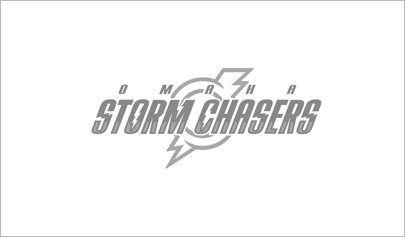



How much does it cost?
Try our Price Calculator to get an Instant Estimate for Your Use Case
PROFESSIONAL PLAN
$ 42 USD
PER USER PER MONTH
$ 35 USD
PER USER PER MONTH

Sports Facilities Management Pain Points
Maintaining High-Traffic Areas in Stadiums and Arenas
Ensuring Safety Standards for Athletes and Spectators
Managing Wear and Tear of Playing Surfaces and Equipment
Integrating Smart Technologies and IoT Systems
Addressing Seasonal and Weather-Related Impacts
Balancing Preventive Maintenance with Event Schedules
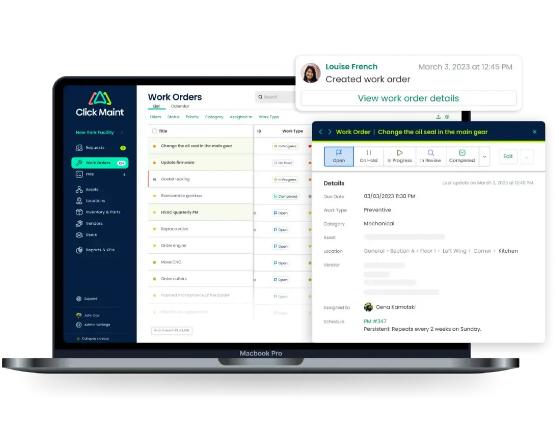
How Sports Facilities Software Solves these
Automated work order management
Asset downtime tracking
Maintenance history reporting
Labor and cost tracking
Inventory management and optimization
Automated preventive maintenance scheduling
CLICK MAINT CMMS FEATURES FOR ARENAS AND STADIUMS
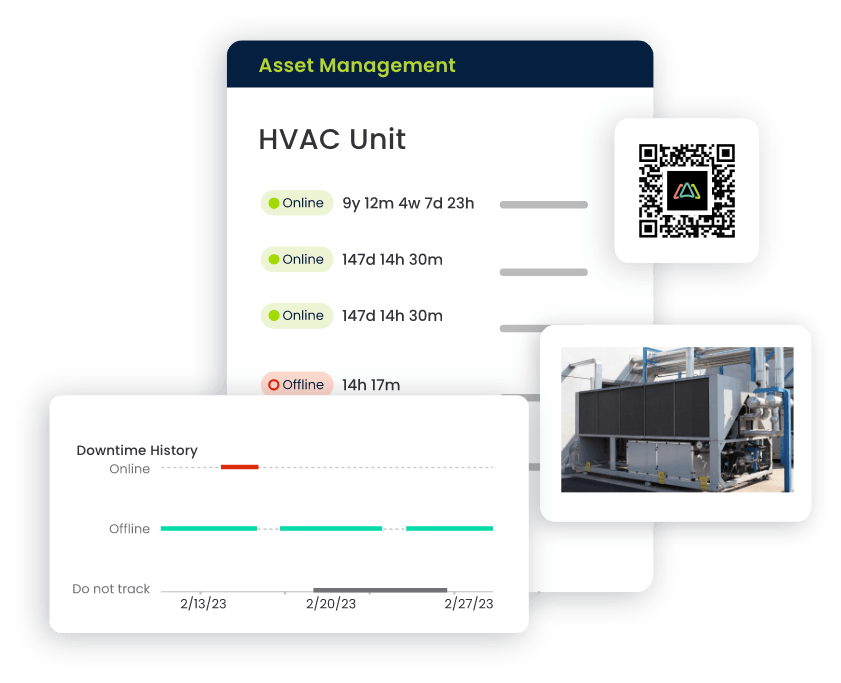
Asset Management
Arenas and stadiums house many critical assets, from MEP (mechanical, electrical & plumbing) equipment, seating arrangements, and scoreboards to audiovisual systems and field surfaces. Keeping track of these assets is essential for timely maintenance, efficient resource allocation, and financial planning.
- Centralized Repository: Click Maint CMMS provides a centralized repository where all assets are cataloged and tracked.
- Easy Identification: Quickly locate assets, reducing downtime during maintenance.
- Maintenance History: Access detailed maintenance history for each asset, aiding decision-making.
- Warranty Management: Keep tabs on warranties, facilitating timely claims and replacements.
- Cost Control: Avoid unexpected expenses by planning and budgeting for asset replacements.
- Modernization: Keep the facility up-to-date with the latest technologies and safety standards.
- Performance Optimization: Continuously assess and upgrade assets for improved performance.
- Sustainability: Plan for eco-friendly asset replacements that align with sustainability goals.
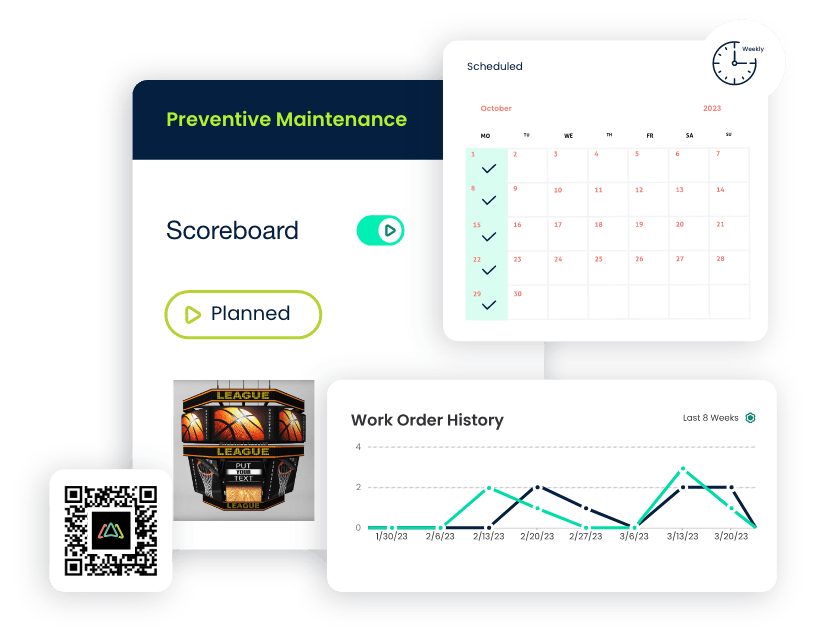
Preventive Maintenance
CMMS software enables facility and maintenance professionals to create customized preventive maintenance plans for each asset type. These plans outline maintenance tasks, schedules, and associated resources.
- Reduced Breakdowns: Minimize unexpected equipment failures during events.
- Improved Reliability: Improve the reliability of critical systems and equipment.
- Predictable Costs: Budget for maintenance expenses and avoid costly emergency repairs.
- Regulatory Compliance: Ensure compliance with safety and industry standards.
- Improved Safety: Regular inspections and maintenance mitigate safety risks.
- Improved Patron Experience: Well-maintained facilities lead to positive guest experiences.
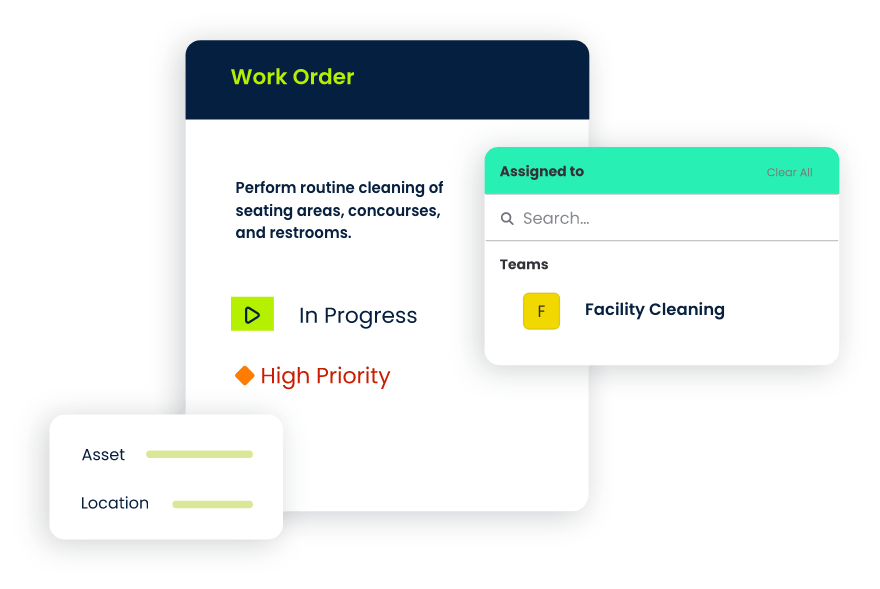
Work Order Management
CMMS streamlines receiving, prioritizing, and managing work requests and work orders. It ensures that maintenance tasks are addressed promptly and efficiently, and prevents needed repairs from falling through the cracks.
- Quick Response: Faster resolution of maintenance requests minimizes disruptions.
- Transparency: Clear documentation of work orders and their status.
- Prioritization: Assign priority levels to work orders based on urgency and importance.
- Audit Trail: Access records of all maintenance activities for accountability, compliance, and audits.
- Task Accountability: Assign specific responsibilities to maintenance personnel.
- Task Tracking: Monitor task status and completion in real time.
- Resource Allocation: Efficiently manage human and material resources.
- Improved Coordination: Improve coordination between maintenance teams and contractors.
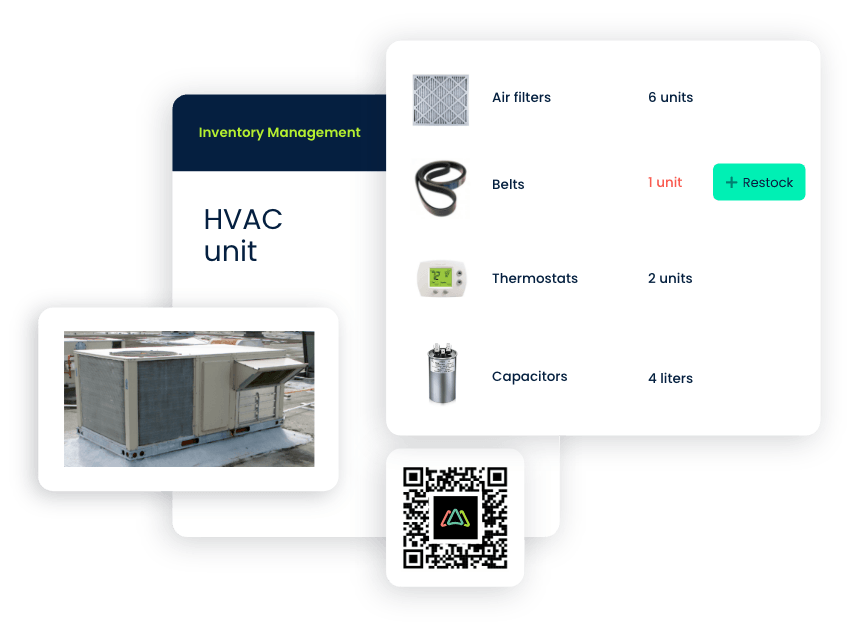
Inventory Management
CMMS software helps maintain an organized inventory of spare parts and supplies required for maintenance tasks, reducing the risk of delays due to stockouts.
- Real-time Visibility: Monitor inventory levels in real-time, reducing the risk of shortages.
- Automated Reordering: Set up automated reorder points to replenish stock when necessary.
- Inventory Optimization: Minimize carrying costs while ensuring the availability of critical items.
- Data-driven Decisions: Use inventory data for budgeting and cost control.
- Reduced Downtime: Ensures necessary parts are always on hand to minimize equipment downtime.
- Cost Savings: Avoid overstocking or understocking, optimizing inventory costs.
- Supplier Management: Streamline ordering and nurture relationships with suppliers and vendors for efficient procurement.
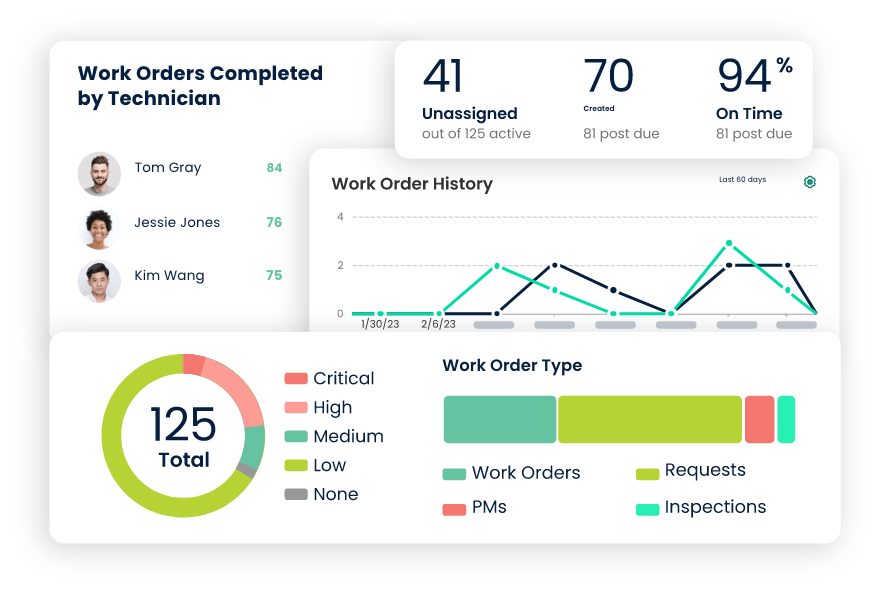
Reporting and Analytics
CMMS provides reporting tools that allow users to generate various maintenance reports, such as asset performance reports, work order history and backlogs, and maintenance cost analyses.
- Data Accessibility: Access relevant maintenance data in an organized and digestible format.
- Performance Analysis: Analyze asset performance and maintenance trends.
- Compliance Reporting: Generate reports for regulatory compliance and auditing purposes.
- Cost Analysis: Evaluate maintenance costs and identify areas for cost reduction.
- Resource Optimization: Identify areas where resources can be reallocated more efficiently.
- Continuous Improvement: Analyze data to improve maintenance strategies.
- Performance Benchmarking: Compare maintenance performance against industry benchmarks.
MOBILE ACCESSIBILITY: STADIUM FACILITIES MANAGEMENT ON THE GO!
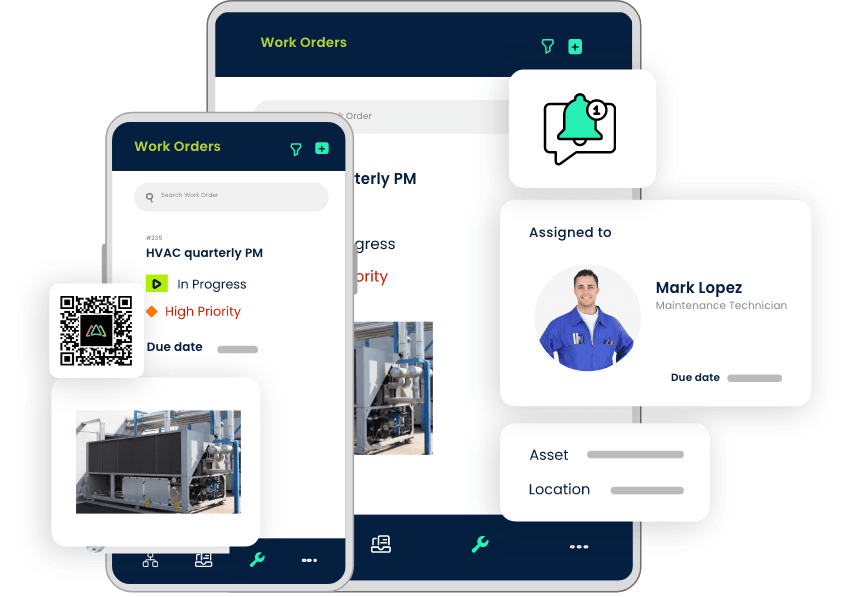
Mobile accessibility extends the power of the CMMS beyond the confines of desktop computers. It allows maintenance teams to access and manage maintenance tasks, asset information, and work orders from smartphones and tablets.
- Real-time Information Access: Access critical maintenance information in real-time, anywhere in the venue. Your maintenance technicians can instantly retrieve data, check asset details, and access work orders, whether in the field, on the arena floor, or in the stands. This real-time access allows faster response times and more efficient issue resolution.
- On-the-go Work Order Management: Maintenance personnel can create, update, and complete work orders directly from their mobile devices. This on-the-go work order management ensures that maintenance tasks are addressed promptly, even during events or high-demand periods. Mobile access eliminates the need for manual paperwork, reducing administrative overhead.
- QR Code Scanning and Image Capture: Staff can use their mobile devices to scan asset QR codes or capture images of assets, allowing for easy identification, work order management, and condition documentation.
- GPS Integration: Allows maintenance teams to pinpoint the exact location of assets or maintenance issues within the facility. This capability is especially valuable in large arenas and stadiums, where precise asset location can be challenging. It ensures that maintenance personnel reach the right spot quickly.
- Offline Access: Network connectivity may only sometimes be reliable in arenas and stadiums, especially in certain areas or during events. Mobile CMMS solutions offer offline access, allowing users to continue working on tasks even when not connected to the internet. Once connectivity is restored, the system syncs data seamlessly.
- Improved Collaboration: Foster better communication and collaboration among maintenance teams. Team members can share updates, access shared documents, and collaborate on tasks using mobile devices. This real-time collaboration ensures everyone is on the same page, leading to more efficient maintenance operations.
Experience Click Maint CMMS now
30-Day Free Trial
No Credit Card needed.
Instant access to all features & modules with an optional live walk-through with a Click Maint expert
Book a live Demo
In this 30-minute demo, see firsthand how our easy CMMS can streamline your operations, enhance productivity, and reduce downtime.
TABLE OF CONTENTS
- Overview of Arenas and Stadiums as Facilities
- Diverse Usage
- High Capacity
- Complex Systems
- Revenue Generation
- Maintenance Challenges Specific to Arenas and Stadiums
- Safety Regulations
- Short Turnarounds
- Downtime Impact
- Equipment Diversity
- Asset Lifecycle Management
- Why Traditional Maintenance Approaches Fall Short
- Benefits of Using CMMS for Arenas and Stadiums
- Improved Maintenance Efficiency
- Cost Reduction
- Improved Asset Management
- Preventive Maintenance
- Improved Safety and Compliance
- Data-Driven Decision-Making
- Improved Guest and Performer Experiences
- Energy Efficiency
- Scalability
- Seamless Communication
- Click Maint CMMS Features for Arenas and Stadiums
- Asset Management
- Preventive Maintenance
- Work Order Management
- Inventory Management
- Reporting and Analytics
- Mobile Accessibility: Stadium Facility Management on the Go!
- CMMS Software Pre-Implementation Considerations
- Assessing Facility Needs
- Selecting the Right CMMS Software
- Budgeting and Resource Allocation
- Best Practices for CMMS Usage in Arenas and Stadiums
- Establishing a Maintenance Strategy
- Setting Key Performance Indicators (KPIs) and Metrics for Success
- Collaborative Workflows
- Regular Software Updates and Maintenance
- Continuous Improvement Culture
OVERVIEW OF ARENAS AND STADIUMS AS FACILITIES
Arenas and stadiums are centers of entertainment, sports, and cultural events that draw thousands, if not millions, of people each year. These multifunctional facilities come in various sizes and shapes, from small community arenas to massive, world-renowned stadiums. While the specific purposes and layouts differ, they all share some common characteristics:
Diverse Usage
Arenas and stadiums host various events, including sports matches, concerts, conventions, exhibitions, and more. Each event type places unique demands on the facility.
High Capacity
These venues accommodate large crowds, so the infrastructure must be robust and well-maintained to ensure safety and comfort.
Complex Systems
From lighting and sound systems to HVAC (Heating, Ventilation, and Air Conditioning) and security, arenas and stadiums incorporate intricate systems that require regular upkeep.
Revenue Generation
Beyond hosting events, these facilities are revenue generators. Efficient operations are essential to maximize profitability.
See how affordable Click Maint CMMS is
MAINTENANCE CHALLENGES SPECIFIC TO ARENAS AND STADIUMS
Safety Regulations
Stringent safety regulations must be adhered to, and any compliance lapses can lead to legal and financial repercussions.
Short Turnarounds
Quick turnarounds between events leave limited time for maintenance activities, making efficiency essential.
Downtime Impact
Downtime can result in significant financial losses, especially during high-profile events. This places enormous pressure on maintenance teams to minimize disruptions.
Equipment Diversity
Arenas and stadiums house diverse equipment, including field surfaces, seating, scoreboards, and complex audiovisual systems. Each requires specialized maintenance.
Asset Lifecycle Management
Managing the lifecycle of assets, such as seating, lighting, and sound systems, is essential to avoid costly replacements.
WHY TRADITIONAL SPORTS FACILITIES MAINTENANCE APPROACHES FALL SHORT
Sports facility management is becoming modern. Traditional maintenance approaches, which often rely on paper-based systems or simple spreadsheets, struggle to meet the demands of arenas and stadiums:
-
Lack of Efficiency: Paper-based systems are time-consuming and prone to errors, leading to inefficiencies and costly delays.
-
Limited Visibility: Traditional methods lack real-time visibility into maintenance needs, making it difficult to prioritize tasks effectively.
-
Compliance Risks: Meeting safety and compliance standards becomes challenging without a centralized system to track and document maintenance activities.
-
Data Silos: Information is typically scattered across various documents and systems, hindering data-driven decision-making.
BENEFITS OF USING CMMS FOR ARENAS AND STADIUMS
Arenas and stadiums are not just venues; they are iconic landmarks that host a wide array of events, from sports tournaments and concerts to exhibitions and conferences. The smooth operation and maintenance of these facilities are essential to delivering exceptional experiences for attendees and performers, and CMMS software can transform how they are managed.
Improved Maintenance Efficiency
CMMS allows facility managers to streamline and automate maintenance tasks. It helps in scheduling preventive maintenance, tracking work orders, and managing asset information, leading to efficient use of resources and reduced downtime. This efficiency ensures that the venue is always in optimal condition for events.
Cost Reduction
Effective maintenance, powered by CMMS, extends the lifespan of equipment and reduces the need for costly emergency repairs. It also helps optimize spare parts inventory, minimizing overstocking or understocking, leading to significant cost savings.
Improved Asset Management
Arenas and stadiums house numerous assets, from lighting systems and HVAC units to seating and scoreboards. CMMS software enables detailed asset tracking, allowing for better maintenance planning, warranty management, and improved decision-making regarding asset replacements or upgrades.
Preventive Maintenance
CMMS helps in creating and implementing preventive maintenance schedules. Regular upkeep ensures that critical equipment remains in top condition, reducing the risk of unexpected breakdowns during events. This proactive approach improves safety and minimizes disruptions.
Improved Safety and Compliance
Safety is paramount in arenas and stadiums. CMMS aids in maintaining compliance with safety regulations by ensuring that all safety-related maintenance tasks are executed promptly and correctly. This not only protects patrons but also mitigates legal and financial risks.
Data-Driven Decision-Making
CMMS generates valuable data and reports about maintenance activities and asset performance. Facility managers can use this data to make informed decisions, identify areas for improvement, and allocate resources more effectively.
Improved Guest and Performer Experiences
A well-maintained facility provides a positive experience for fans, performers, and event organizers. CMMS helps ensure that the venue's infrastructure (MEP equipment, seating, lighting, and sound systems) operates flawlessly, enhancing the overall event experience.
Energy Efficiency
Arenas and stadiums are known for their high energy consumption. CMMS software can be integrated with building management systems to monitor energy usage and optimize HVAC, lighting, and other systems for energy efficiency. This not only reduces operational costs but also aligns with sustainability goals.
Scalability
CMMS solutions are scalable and can adapt to the evolving needs of arenas and stadiums. Whether you're managing a small local stadium or a massive international arena, A CMMS can accommodate your facility and scale with growth initiatives.
Seamless Communication
CMMS facilitates communication among maintenance teams, contractors, and other stakeholders. It ensures everyone is on the same page regarding maintenance tasks, work orders, and priorities, leading to better coordination and faster resolution.
CMMS SOFTWARE PRE-IMPLEMENTATION CONSIDERATIONS
Assessing Facility Needs
Before embarking on the CMMS implementation journey, conducting a thorough assessment of the facility's maintenance needs is essential. This assessment should encompass the following:
- Inventory of Assets: Identify and catalog all venue equipment, systems, and infrastructure that need maintenance.
- Maintenance Requirements: Determine the specific maintenance needs for each asset, including frequency, tasks, and criticality.
- Regulatory Compliance: Understand the safety and compliance standards relevant to arenas and stadiums.
- Resource Availability: Assess the availability of personnel, tools, and materials for maintenance.
Selecting the Right CMMS Software
Choosing the appropriate CMMS software is very important. Factors to consider include:
- Scalability: Ensure the CMMS can accommodate the scale and complexity of your facility, whether it's a local stadium or a large arena. If there are plans to expand CMMS usage to multiple sites or departments, ensure that the CMMS application can accommodate future growth.
- Customization: Look for software that can be tailored to meet the unique maintenance requirements of arenas and stadiums.
- User-friendly Interface: Opt for a system that is easy for maintenance staff to use. Selecting a CMMS that is easy to use will help ensure users adopt the software and get more ROI.
- Mobile Accessibility: Check if the CMMS offers mobile access for on-the-go maintenance tasks.
Budgeting and Resource Allocation
Determine the financial resources needed for CMMS implementation and ongoing maintenance. Allocate funds for:
- Software Acquisition: The cost of purchasing or subscribing to the CMMS software.
- Hardware and Infrastructure: Ensure the necessary hardware and network infrastructure are in place. With cloud-based CMMS platforms, hardware like servers are provided and managed by the software provider. The client provides mobile devices like tablets and smartphones.
- Training and Support: Budget for staff training, technical support, and software updates.
- Integration Costs: Consider expenses related to integrating the CMMS with existing systems.
BEST PRACTICES FOR CMMS USAGE IN ARENAS AND STADIUMS
Establishing a Maintenance Strategy
Comprehensive Asset Inventory: Begin by creating a detailed inventory of all assets within the facility, ranging from seating and lighting to HVAC systems and audiovisual equipment. This inventory forms the basis of your maintenance strategy.
- Asset Prioritization: Prioritize assets based on their criticality to the facility's operations and safety. Identify high-impact assets that require more frequent attention and allocate resources accordingly.
- Asset Lifecycle Management: Develop a clear asset lifecycle management plan that outlines when assets need to be replaced, upgraded, or retired. This long-term perspective helps in budgeting and resource allocation.
- Preventive Maintenance Planning: Create preventive maintenance plans for each asset category. Specify maintenance tasks, schedules, and required resources. Tailor preventive maintenance to the unique needs of arenas and stadiums.
Setting Key Performance Indicators (KPIs) and Metrics for Success
Define a set of KPIs to measure the performance of your maintenance operations. Examples of KPIs include equipment uptime, maintenance cost per asset, mean time between failure (MTBF), and mean time to repair (MTTR).
- Data Collection and Analysis: Utilize your CMMS to collect and analyze data related to maintenance activities. Regularly review KPIs to identify trends, areas for improvement, and opportunities to optimize resource allocation.
- Benchmarking: Compare your maintenance performance against industry benchmarks. Benchmarking can help you identify areas where you excel and areas that require improvement.
- Continuous Monitoring: Set up real-time monitoring of critical assets using IoT devices and sensors. This enables proactive maintenance and reduces the risk of unplanned downtime.
Collaborative Workflows
- Cross-functional Collaboration: Foster collaboration between maintenance teams, event management, security, and other relevant departments. Effective communication and teamwork improve the overall efficiency of the facility.
- Digital Workflows: Leverage the workflow capabilities of your CMMS to streamline maintenance processes. Ensure that work orders, requests, and approvals are managed efficiently within the system.
- Guest Feedback Integration: Consider integrating guest feedback into your CMMS. Guest-reported issues can be linked directly to maintenance tasks, ensuring that guest concerns are addressed promptly.
Regular Software Updates and Maintenance
- Stay Current: Keep your CMMS software current by applying regular updates and patches. This ensures you have access to the latest features, bug fixes, and security improvements. Cloud-based CMMS software has automatic updates managed by the provider, eliminating the burden of installing updates on the client’s IT department. CMMS users can stay up to date with software updates by attending software provider webinars, training refreshers, and subscribing to the software provider’s newsletter.
- Data Backups: Implement a robust data backup strategy to safeguard your maintenance records and asset information. Regularly backup your CMMS data to prevent data loss in the event of system failures.
- Security Measures: Pay close attention to cybersecurity. Protect sensitive maintenance data by implementing security measures such as user access controls, encryption, and regular security audits. Many cloud-based CMMS systems implement strict security and compliance measures to reduce the risk of customer data being compromised.
Continuous Improvement Culture
- Feedback Loop: Establish a feedback loop that encourages maintenance staff to share their insights and suggestions for process improvement. Act on feedback to drive ongoing improvements.
- Training and Skill Development: Invest in continuous training and skill development for maintenance teams. Ensure they are proficient in using the CMMS and are updated on best practices and industry trends.
- Lean Principles: Apply lean maintenance principles to eliminate waste, reduce downtime, and optimize resource allocation. Lean practices can lead to cost savings and operational efficiency.
- Regular Audits: Conduct periodic audits of your CMMS usage to identify areas where you can improve efficiency, data accuracy, and adherence to maintenance protocols.


